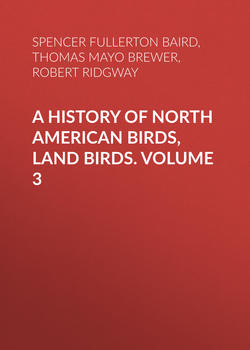Читать книгу A History of North American Birds, Land Birds. Volume 3 - Robert Ridgway - Страница 1
RAPTORES. 1 —The Birds of Prey
ОглавлениеThe group of birds usually known as the Raptores, or Rapacious Birds, embraces three well-marked divisions, namely, the Owls, the Hawks, and the Vultures. In former classifications they headed the Class of Birds, being honored with this position in consequence of their powerful organization, large size, and predatory habits. But it being now known that in structure they are less perfectly organized than the Passeres and Strisores, birds generally far more delicate in organization, as well as smaller in size, they occupy a place in the more recent arrangements nearly at the end of the Terrestrial forms.
The complete definition of the order Raptores, and of its subdivisions, requires the enumeration of a great many characters; and that their distinguishing features may be more easily recognized by the student, I give first a brief diagnosis, including their simplest characters, to be followed by a more detailed account hereafter.
Common Characters. Bill hooked, the upper mandible furnished at the base with a soft skin, or “cere,” in which the nostrils are situated. Toes, three before and one behind. Raptores.
Strigidæ. Eyes directed forwards, and surrounded by radiating feathers, which are bounded, except anteriorly, by a circle or rim of differently formed, stiffer feathers. Outer toe reversible. Claws much hooked and very sharp. Legs and toes usually feathered, or, at least, coated with bristles. The Owls.
Falconidæ. Eyes lateral, and not surrounded by radiating feathers. Outer toe not reversible (except in Pandion). Claws usually hooked and sharp, but variable. Head more or less completely feathered. The Hawks.
Cathartidæ. Eyes lateral; whole head naked. Outer toe not reversible; claws slightly curved, blunt. The Vultures.
The preceding characters, though purely artificial, may nevertheless serve to distinguish the three families of Raptores belonging to the North American Ornis; a more scientific diagnosis, embracing a sufficient number of osteological, and accompanying anatomical characters, will be found further on.
The birds of prey—named Accipitres by some authors, and Raptores or Rapaces by others, and very appropriately designated as the Ætomorphæ by Professor Huxley—form one of the most strongly characterized and sharply limited of the higher divisions of the Class of Birds. It is only recently, however, that their place in a systematic classification and the proper number and relation of their subdivisions have been properly understood. Professor Huxley’s views will probably form the basis for a permanent classification, as they certainly point the way to one eminently natural. In his important paper entitled “On the Classification of Birds, and on the Taxonomic Value of the Modifications of certain Cranial Bones observable in that Class,”2 this gentleman has dealt concisely upon the affinities of the order Raptores, and the distinguishing features of its subdivisions. In the following diagnoses the osteological characters are mainly borrowed from Professor Huxley’s work referred to. Nitzsch’s “Pterylography”3 supplies such characters as are afforded by the plumage, most of which confirm the arrangement based upon the osteological structure; while important suggestions have been derived from McGillivray’s “History of British Birds.”4 The Monographs of the Strigidæ and Falconidæ, by Dr. J. J. Kaup,5 contain much valuable information, and were they not disfigured by a very eccentric system of arrangement they would approach nearer to a natural classification of the subfamilies, genera, and subgenera, than any arrangement of the lesser groups which I have yet seen.
The species of this group are spread over the whole world, tropical regions having the greatest variety of forms and number of species. The Strigidæ are cosmopolitan, most of the genera belonging to both continents. The Falconidæ are also found the world over, but each continent has subfamilies peculiar to it. The Cathartidæ are peculiar to America, having analogous representatives in the Old World in the subfamily Vulturinæ belonging to the Falconidæ, The Gypogeranidæ are found only in South Africa, where a single species, Gypogeranus serpentarius (Gmel.), sole representative of the family, is found.
As regards the comparative number of species of this order in the two continents, the Old World is considerably ahead of the New World, which might be expected from its far greater land area. 581 species are given in Gray’s Hand List,6 of which certainly not more than 500, probably not more than 450, are valid species, the others ranking as geographical races, or are synonymous with others; of this number about 350 nominal species are accredited to the Old World. America, however, possesses the greatest variety of forms, and the great bulk of the Old World Raptorial fauna is made up chiefly by a large array of species of a few genera which are represented in America by but one or two, or at most half a dozen, species. The genera Aquila, Spizætus, Accipiter, Haliætus, Falco, Circus, Athene, Strix, and Buteo, are striking examples. As regards the number of peculiar forms, America is considerably ahead.
2
By Thomas H. Huxley, F. R. S., V. P. Z. S.; Proceedings of the Zoölogical Society of London, 1867, pp. 415–473.
3
By Charles Ludwig Nitzsch. English edition, translated from the German by Dr. Philip Lutley Sclater, and published by the Ray Society of London, 1867.
4
By William McGillivray, A. M.; London, 1840.
5
See Jardine’s Contributions to Ornithology, London, 1849, p. 68; 1850, p. 51; 1851, p. 119; 1852, p. 103; and Transactions of the Zoölogical Society of London, 1862, p. 201.
6
Hand List of Genera and Species of Birds, distinguishing those contained in the British Museum. By George Robert Gray, F. R. S., etc. Part I. Accipitres, Fisserostres, Tenuirostres, and Dentirostres. London, 1869.
